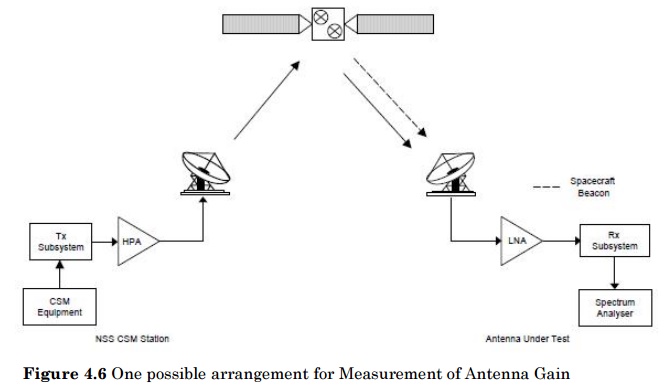Chapter: Satellite Communication : Earth Segment
Antenna Gain
Antenna Gain:
Antenna
gain is usually defined as the ratio of the power produced by the antenna from
a far-field source on the antenna's beam axis to the power produced by a
hypothetical lossless isotropic antenna, which is equally sensitive to signals
from all directions.

Two
direct methods of measuring the Rx gain can be used; integration of the Rx
sidelobe pattern or by determination of the 3dB and 10dB beamwidths.
The
use of pattern integration will produce the more accurate results but would
require the AUT to have a tracking system. In both cases the test
configurations for measuring Rx gain are identical, and are illustrated in
Figure.
In
order to measure the Rx gain using pattern integration the AUT measures the
elevation and azimuth narrowband (±5° corrected) sidelobe patterns.
The
AUT then calculates the directive gain of the antenna through integration of
the sidelobe patterns. The Rx gain is then determined by reducing the directive
gain by the antenna inefficiencies.
In
order to measure the Rx gain using the beamwidth method, the AUT measures the
corrected azimuth and elevation 3dB/10dB beamwidths. From these results the Rx
gain of the antenna can be directly calculated using the formula below.

where:
G
is the effective antenna gain (dBi)
Az3
is the corrected azimuth 3dB beamwidth (°)
El3
is the elevation 3dB beamwidth (°)
Az10
is the corrected azimuth 10dB beamwidth (°)
El10
is the elevation 10dB beamwidth (°)
FLoss
is the insertion loss of the feed (dB)
RLoss
is the reduction in antenna gain due to reflector inaccuracies, and is given
by:
RLoss =4.922998677(Sdev f )2 dB
where:
Sdev is the standard deviation of the actual reflector surface
(inches)
f
is the frequency (GHz)
Related Topics